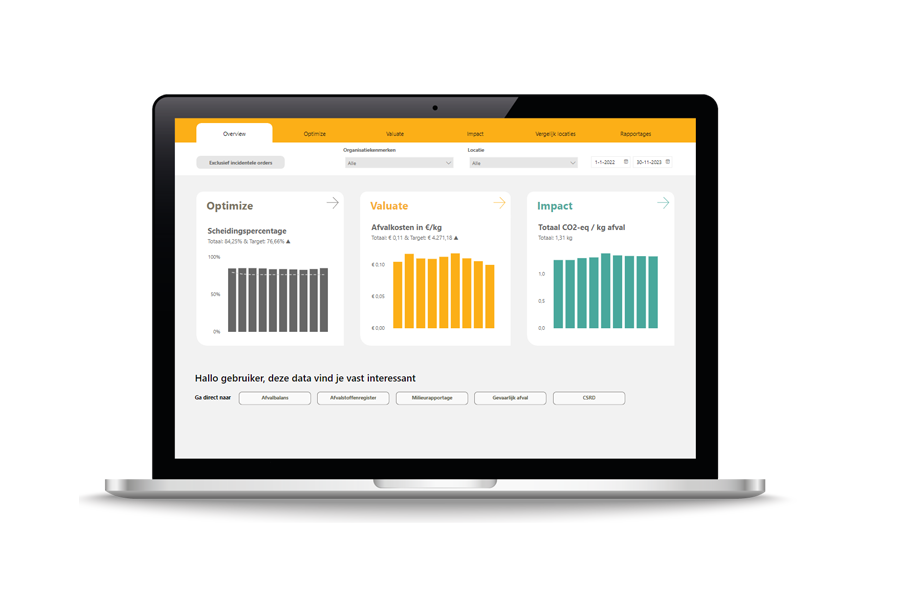In the mobility sector, efficient waste management is becoming increasingly important due to increasing costs and stricter sustainability standards. With these increasing pressures, companies in the mobility sector face the challenge of optimizing their processes. Benchmarking offers an effective way to understand inefficiencies within waste management and how to improve them. In this blog, we explain what benchmarking is and how it can add value for companies in the mobility sector.
What is benchmarking?
Benchmarking is the process of comparing different aspects of a company, such as locations, departments, number of FTEs, costs, and waste streams. Based on these figures, companies can see where they can improve. In the context of waste management, benchmarking helps companies reduce costs, improve waste separation, and comply with laws and regulations, such as the CSRD (Corporate Sustainability Reporting Directive).
The benefits of benchmarking
A clear example of how benchmarking can identify inefficiencies is through better waste segregation and recycling of valuable materials such as batteries. This leads to lower transportation and processing costs. Benchmarking also provides better insight into waste streams, including hazardous waste. By comparing data, companies can develop more efficient processes for separating, storing and processing waste. In this way, they comply with applicable regulations, avoid fines or additional costs, and contribute to a more sustainable business model at the same time.
An additional benefit of benchmarking is that in addition to optimizing their waste management, it also helps companies comply with reporting requirements such as the CSRD. By comparing data from different locations and departments, companies can identify and address inconsistent performance. This provides a more complete and accurate overview of their overall waste streams. With these insights, companies can provide the right data for CSRD reports, such as the proportion of material recycled, the degree of waste segregation, and produce them faster and more efficiently.
In addition, benchmarking provides the following benefits:
- Environmental gain: By comparing data from different sites, companies can see where waste reduction and recycling can be better applied. This leads to less waste, more reuse of materials and a smaller carbon footprint, contributing to a circular economy.
- Reputation enhancement: By measuring and optimizing their sustainability efforts, companies demonstrate that they are actively working to improve efficiency and environmental friendliness. This strengthens their image among customers, suppliers and investors as a reliable and environmentally conscious partner.
- Greater control in your waste streams: By gaining continuous insight into the performance of different sites, companies gain insight into where performance differs and where there are opportunities to improve. For example, if one site recycles significantly less than other sites, that may indicate bottlenecks that need to be addressed. This makes it easier to make targeted adjustments and intervene quickly, making waste management more efficient and saving costs.
Benchmarking in practice
At Milgro, we use benchmarks to compare different sites of a company based on four key performance indicators (KPIs):
- Total cost per mechanic: This KPI measures how much a company spends on average per mechanic on waste management. This helps companies understand which facilities are spending more and where cost savings can be made.
- Total cost per kilogram of waste: This indicates how much it costs to process one kilogram of waste. If a site has a higher cost per kilogram of waste than other sites, this may indicate inefficiencies, such as unnecessary waste streams or expensive processing techniques.
- Residual waste per mechanic: This provides insight into the amount of unsorted waste a mechanic produces on average. For example, when a site exceeds the predetermined amount of kilograms per mechanic per month, it is analyzed in more detail. Thus, opportunities for improvement, such as better waste separation or reuse of materials, can be identified.
- Waste separation rate: This indicates the percentage of total waste that is separated for recycling. A lower separation rate may indicate that valuable materials are being lost unnecessarily or that waste separation and recycling processes are inefficient. By comparing the waste separation rate between different sites, companies can see which sites are performing well and which are lagging behind. This allows successful methods from high-performing sites to be adopted and implemented at other sites, helping to improve overall separation rates and save costs.
By using these KPIs, we can quickly identify sites that are performing above or below standard. For example, a site that produces more residual waste than others is examined more closely to see why this is happening. Perhaps there is a problem with waste segregation, or inefficient handling of specific waste streams such as aerosol cans or batteries. Then we make concrete recommendations to improve that location, such as installing more recycling stations or better educating mechanics about waste separation.
The traffic light model as a tool
The traffic light model is originally used in the mobility industry to estimate the amount of work for a car repair. Green light means a simple repair, while red light probably requires more time and expertise. This same model is applied within benchmarking waste management in the mobility sector. It provides insight into where inefficiencies occur in terms of waste management and cost reduction, after which an appropriate optimization proposal is developed. These inefficiencies are determined using four KPIs, as mentioned above.
For the mobility sector, the KPI "total cost per mechanic" is of great importance because the number of mechanics can vary greatly from one organization to another. In this way, entirely different locations can still be properly compared. For example, if a location has a relatively high price per kilogram of waste, but the KPI 'residual waste per mechanic' shows a low amount, this is an indication (red light) that the location should be investigated further so that optimization proposals can be made.
Compliance and the CSRD
Starting in 2025, the CSRD requires large companies, that is, those with more than 250 employees, net sales of more than €40 million or a balance sheet total of more than €20 million, to prepare detailed reports on their sustainability practices. These reports must provide insight into issues such as environmental impact, energy consumption and waste management. Many mobility companies fall under these guidelines.
Milgro supports mobility companies in this process through data analysis and benchmarking so they can easily report while improving their waste management. By comparing data from different locations and processes, companies get a complete and accurate picture of their waste streams, which is important for CSRD reporting. This helps companies not only to comply with reporting requirements, but also to make targeted improvements. Thus, Milgro relieves companies of the reporting pressure and ensures that companies are ready for upcoming obligations.

Want to know more?
Want to learn more about benchmarking and how Milgro can assist your company with data insights? Try the trail of our online dashboard and discover how you can easily access valuable information about your waste streams. Additionally, you can always reach out to our experts for a free (online) consultation, where we are happy to assist you further.
Stay informed
Stay informed about all the latest development? Follow us on LinkedIn and Instagram or subscribe to the newsletter. Are you curious about what Milgro can mean for your business operations and waste process? Then contact us.












